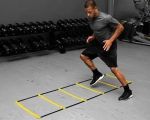How I Built My Home Gym on a Budget
As someone who's always enjoyed working out, the idea of building a home gym became a dream of mine. But, like many others, I faced the challenge of making fitness a priority without draining my savings. In this article, I’ll share my journey of building a home gym on a budget and give you practical tips on how you can do the same!
1. Assess Your Space and Needs
Before you start buying equipment, the first step is to evaluate your space. My apartment didn’t have a lot of extra room, but I knew I could convert a small corner into a workout area. This is an important step because knowing the available space helps you plan how much equipment you can fit without feeling crowded.
Consider the types of exercises you enjoy. Are you into weight training, yoga, or cardio? These decisions will guide you in purchasing only what you need, avoiding unnecessary spending on equipment you won’t use. I focused on a few versatile pieces that would work for a variety of workouts.
2. Start with Essential Equipment
Building a gym at home doesn’t require expensive, high-end machines. Instead, start with the essentials—items that are versatile, durable, and cost-effective. Here’s where I began:
- Resistance Bands: These are affordable, portable, and incredibly effective. I use them for strength training, flexibility exercises, and even as a warm-up. You can find a decent set of resistance bands for less than $20.
- Dumbbells: A set of adjustable dumbbells is an absolute must-have. While the initial investment may be higher than other items, they are incredibly versatile and will last for years. I started with a set of lighter weights and gradually increased the load.
- Jump Rope: For cardio workouts, a jump rope is one of the best investments you can make. It’s inexpensive, easy to store, and provides an excellent cardio workout. Plus, you can get one for under $15!
3. Look for Deals and Discounts
Once you know what equipment you need, start hunting for deals. I discovered that many online retailers offer substantial discounts, especially around holiday seasons or during sales events. Here are some places I found great deals:
- Amazon: The first place I checked was Amazon, where you can often find budget-friendly options for equipment. The reviews are also helpful for gauging the quality of products.
- Thrift Stores and Secondhand Sales: Don't overlook the value of second-hand equipment. I found some incredible deals at thrift stores and local Facebook marketplace listings. Be sure to check for wear and tear before buying used items.
- Retailer Sales: Local sporting goods stores frequently hold sales, especially during New Year’s when many people are making resolutions to get fit. I scored some great deals this way!
4. Make Use of DIY Solutions
If you’re really looking to save, consider creating your own equipment. I made my own sandbag for strength training by filling a heavy-duty bag with sand and sealing it. It cost me less than $10, and it has worked great for my workouts!
Another DIY solution I implemented was making a balance board using a wooden board and a cylindrical object I found at a hardware store. It was a fun project and gave me an additional tool for improving my balance and stability.
5. Get Creative with Your Workouts
One of the great things about having a home gym is that you can get creative with your workouts. I don’t rely on machines or fancy equipment. Instead, I use bodyweight exercises, resistance bands, dumbbells, and household items as part of my fitness routine. Here are a few examples:
- Chairs for Step-ups and Tricep Dips: You don’t need a bench to do these exercises—just a sturdy chair from your kitchen or living room.
- Towels for Sliders: I use towels on hardwood floors for exercises like mountain climbers, lunges, and hamstring curls.
- Backpack for Added Resistance: Fill a backpack with books and use it for squats or lunges to add extra resistance.
6. Keep Your Gym Organized
To ensure that your home gym remains functional and inviting, it’s essential to stay organized. I purchased simple storage solutions like bins and wall hooks to keep everything tidy. I also made sure to set up a designated area for my gym to keep me motivated and prevent clutter from taking over the space.
As your collection of equipment grows, be mindful of how much space each item occupies. Having an organized space not only makes your workouts more enjoyable but also helps you avoid stepping on dumbbells or tripping over resistance bands!
7. Stay Consistent with Your Fitness Goals
Building a home gym on a budget is just the first step. The real challenge comes with staying consistent. To help with motivation, I created a workout schedule and stuck to it, even when life got busy. There were days when I felt tempted to skip a workout, but having my gym just steps away from my living room made it easy to stay committed.
Ultimately, the key to success with a home gym is consistency. You don’t need to spend a fortune to stay fit and healthy. With a little creativity, you can build an effective, affordable workout space right at home.
Remember, it’s not about how fancy your equipment is—it’s about making the most of what you have and staying dedicated to your fitness journey.








